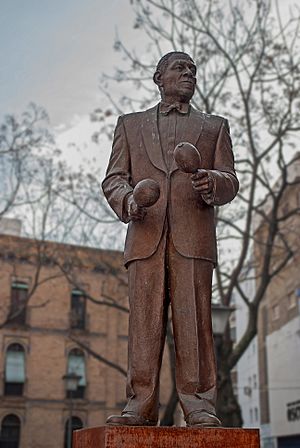Antonio Machín facts for kids
Quick facts for kids
Antonio Machín
|
|
|---|---|
 |
|
| Born |
Antonio Abad Lugo Machín
February 11, 1903 |
| Died | August 4, 1977 |
| Resting place | Cemetery of San Fernando, Seville, Spain |
| Spouse(s) |
María de los Ángeles Rodríguez
(m. 1943) |
| Children | 1 |
Antonio Machín (born February 11, 1903, in Sagua la Grande, Cuba; died August 4, 1977, in Madrid, Spain) was a famous Spanish-Cuban singer and musician. He was known for his song El Manisero (The Peanut Vendor). This song, recorded in 1930, was the first by a Cuban artist to sell a million copies!
Even though it sounded like a rhumba, it was actually a son pregón. This means it was a song based on a street seller's cry.
Contents
Antonio Machín's Life Story
Antonio Machín had a Cuban mother and a Spanish father. He was one of sixteen children in his family. Life was tough when he was young. He started working at age eight to help his family.
One day, a priest heard him singing on the street. The priest was impressed and asked him to sing at a party. Antonio sang the famous song Ave María. From that day on, Antonio knew he wanted to be a singer.
Becoming a Singer
Antonio dreamed of singing opera. But in the early 1900s, it was hard for a poor Cuban person to do this. So, he decided to sing popular music instead. By age twenty, he was very popular with young women in his neighborhood. He would sing them serenades under the moonlight.
He worked as a mason, which is someone who builds with stone or brick. He also traveled around Cuba as a singer. In 1926, he moved to Havana. There, he met a Spaniard who helped him get a singing job at a small café.
Music in Havana and New York
In Havana, Antonio learned about many types of music. He joined different music groups like trios, quartets, and sextets. In 1924, he formed a duo with another singer named Miguel Zaballa. Later, he joined the Trío Luna.
In 1926, he joined Don Azpiazú's orchestra. This was the main band at the Havana Casino. In 1930, he went to New York City with Don Azpiazú's band. That's where they recorded El Manisero (The Peanut Vendor). This song became the first Cuban hit in the U.S. and helped start the rhumba dance craze.
Antonio did not go back to Cuba after this tour. He stayed in New York for a while.
Recording in New York
In New York, Antonio Machín recorded about 200 songs. In 1932, he started his own group called the Cuarteto Machín. The other members were from Puerto Rico: Plácido Acevedo (who played the trumpet), Cándido Vicenty (who played the tres), and Daniel Sánchez (who sang and played guitar). Antonio was the main singer.
Sometimes other musicians joined, and the group became the Sexteto Machín. Antonio also sang with other bands like José Escarpenter y su Orquesta and Orquesta Antillana.
Moving to Europe
In 1935, Antonio moved to Europe. He lived in London and Paris before settling in Madrid, Spain, in the late 1930s. He stayed in Madrid until he passed away.
In Paris, he formed "Antonio Machín y su Orquesta." He continued to record music there. Cuban music was very popular in Paris at that time.
Life in Spain
After moving to Madrid, he married María de los Ángeles Rodríguez in 1943. She was from Seville. As the Cuarteto Machín, he made over 60 recordings in Spain. He often sang songs by famous composers like Oswaldo Farrés and Consuelo Velázquez.
He also recorded many songs with different Spanish bands. He recorded about 400 songs in Europe. This means he recorded around 600 songs in his whole life! This makes him one of the most recorded Cuban singers of the 20th century.
Antonio Machín passed away in Madrid in 1977. He was buried in the San Fernando Cemetery in Seville. He is most famous for singing El Manisero, Dos gardenias, Madrecita, and Angelitos negros.
Images for kids
See also
 In Spanish: Antonio Machín para niños
In Spanish: Antonio Machín para niños


